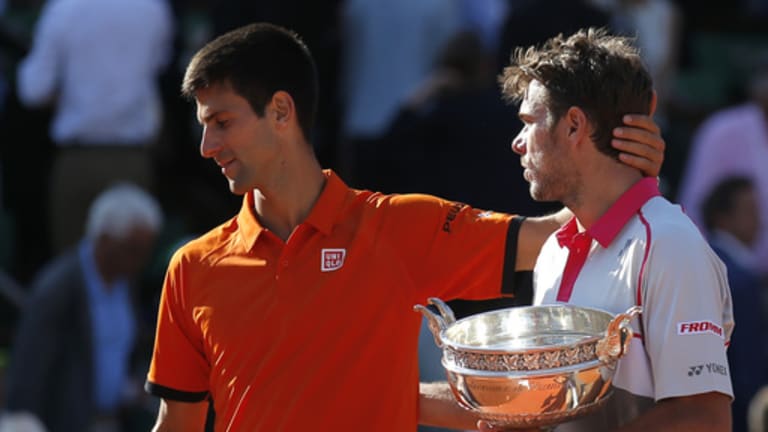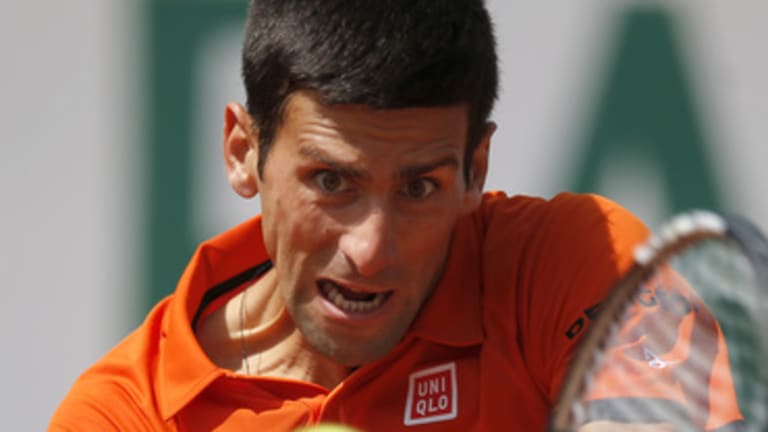Top 10 Matches of 2015, No. 7: Stan Mans Up
By Steve Tignor Dec 09, 2015Joao Fonseca wins Masters 1000 debut in Madrid over fellow teen Alex Michelsen
By TENNIS.com Apr 25, 2024Adrian Mannarino has a clothing sponsor! Lefty to debut with Celio at Mutua Madrid Open
By Baseline Staff Apr 25, 2024FFT to reveal second retractable roof court at Roland Garros ahead of Paris Olympics
By Associated Press Apr 25, 2024Rafael Nadal wins in Madrid homecoming, defeats 16-year-old American Darwin Blanch
By David Kane Apr 25, 2024Dominant Coco Gauff double bagels Arantxa Rus in Madrid opener
By David Kane Apr 25, 2024Maria Sakkari shakes off BJK Cup fatigue, brings clear mind to Madrid clay
By David Kane Apr 25, 2024Naomi Osaka loses in Madrid, bows out to Liudmila Samsonova on clay
By David Kane Apr 25, 2024Geared Up: Rafael Nadal plays out his illustrious career with Babolat and Nike
By Baseline Staff Apr 25, 2024China's Wang Xinyu saves 10 match points in first-round Madrid win over Viktoriya Tomova
By TENNIS.com Apr 24, 2024Top 10 Matches of 2015, No. 7: Stan Mans Up
Looking back at Wawrinka's stunning win over Djokovic in Paris.
Published Dec 09, 2015
Advertising
What do we do now that the 2015 season is over and tennis is in its all-too-brief December recess? Go back and watch the best matches of the year, of course. Over the next two weeks, I’ll count down my 10 favorite contests, accompanied by video highlights, of this season.
No. 10: The Day the Circus Came to Town—Kyrgios d. Federer, Madrid
No. 9: New York Knockdown—Azarenka d. Kerber, U.S. Open
No. 8: Cup Runneth Over, and Over, and Over—Mayer d. Souza, Davis Cup
No. 7: Stan Mans Up—Wawrinka d. Djokovic, Roland Garros
No. 6: Simona Finds the Power—Halep d. Azarenka, U.S. Open
No. 5: Sending the Open Into Orbit—Fognini d. Nadal, U.S. Open
No. 4: Richard the...Lion-Hearted?—Gasquet d. Wawrinka, Wimbledon
No. 3: The Serena & Simona Show—Williams d. Halep, Miami
*No. 2: Vincanity—Vinci d. Williams, U.S. Open
No. 1: Fierce and Fiercer—Williams d. Azarenka, Wimbledon<em>*</em>
The problem with winning every match except one is that people tend to remember your lone defeat better than all of your victories. Just ask Novak Djokovic and Serena Williams. Yes, each of the them won three majors in 2015, and, yes, each came within a hair’s breadth of completing this century’s first calendar-year Grand Slam. But when you think of their seasons, which of their matches comes to mind first? Unfortunately, if you’re like me, it’s the one that got away. Serena’s was her semifinal defeat to Roberta Vinci at the U.S. Open. Djokovic’s was his 4-6, 6-4, 6-3, 6-4 final-round loss to Stan Wawrinka at the French Open.
When it came to creating memorable matches this year, Djokovic was a victim of his own excellence. Like Serena, he showed a knack for taking a match that was threatening to become an epic and finishing it with a 6-0 or 6-1 final set instead. Djokovic, who was on a 27-match winning streak by the time he reached the French Open final, started the season by bageling Wawrinka in the fifth set of their Australian Open semifinal, and finished it by bageling him in the third (and final) set of their semifinal at the Paris Masters.
The same thing could easily have happened at Roland Garros, too, but Stan never let it get to a decisive set. While there were more competitive and dramatic men’s matches in 2015, Wawrinka gave us the performance of the year in his first French Open final. That’s what it took to beat Djokovic at a major.
Before the match, Wawrinka had expressed amazement that he had made it that far.
“My dream was to play Roland Garros, not win it, not to reach the final,” he said. “To me, the players that did that were mutants.”
Welcome to the X-Men, Stan. Here’s a look, as captured in the video above, at the heavy-hitting highlights of what Wawrinka called the best day of his career.
Advertising

Top 10 Matches of 2015, No. 7: Stan Mans Up
© AP
—“It was almost a match in a rally,” one commentator exclaims after a long early point. While this final is remembered primarily for Wawrinka's sustained bombing run, it was also as physically debilitating as any important match played this season. Its four sets took 3 hours and 12 minutes, and that fact, as much as Stan’s standout effort, may have been what doomed Djokovic. Having been forced to finish his five-set semifinal with Andy Murray the previous day, he was uncharacteristically weary down the homestretch here. The fact that Roland Garros’ schedulers, with just two matches to complete on Friday, couldn’t find a way to get them both in was inexcusable.
“I tried to make him move, play really hard,” Wawrinka said afterward. “I start to play more heavy after the first set, start to play long rallies, which helped me.”
—”Whoa!” we hear the same commentator blurt after Wawrinka clubs a forehand winner in the opening set. That wouldn’t be the last time one of his shots elicited this collective reaction from the audience. There was a certain sound—flat, metallic, leaden—that Stan's shots made during his last three matches in Paris, when he beat Roger Federer, Jo-Wilfried Tsonga, and Djokovic in succession. In the final, Wawrinka hit 60 winners, Djokovic 30. More important, Wawrinka made just 45 errors to Djokovic’s 41. Stan commanded the baseline without having to play with an uncomfortable amount of risk. And he seemed to have a roundhouse backhand ready for every big moment. He hit just 11 winners from that side, but it felt like more, because all of them were memorable.
Advertising

Top 10 Matches of 2015, No. 7: Stan Mans Up
© AP
—Still, through the first set, it appeared as if everything was going according to plan for Djokovic, who came into the match with a 19-3 career record against Wawrinka. At 3-3, Djokovic broke at love on a Wawrinka double fault, and, like the gritty champion he is, he used his serve to bail himself out of trouble at 5-4. Yet an alarming number of Wawrinka’s shots were finding the outside of the tape, and he finished the first set with 12 winners.
—Did those tape-clipping winners throw a sliver of self-doubt into Djokovic? For whatever reason, starting in the second set, he began to go to the drop shot more often than normal. This had been a reliable weapon of his during the clay-court swing, and he won a lot of points with it against Wawrinka. By 4-4, Stan was so frustrated by his inability to do anything with the Djokovic drop shot that he pounded the net with his racquet. Yet by going to the dropper so often, and from well behind the baseline, Djokovic ceded the initiative to Wawrinka. It was as if Djokovic suddenly felt like he couldn’t win the extended rallies that he had been winning all year.
—Wawrinka seized the initiative at the end of the second set; four points were enough to turn the match in his favor. With Djokovic serving at 4-5, 30-0, Wawrinka fired off a big backhand pass and an even bigger down the line forehand. Staggered by those punches, Djokovic made two backhand errors to lose the set, and smashed his racquet. Having let Stan into the match, he must have known how tough it would be to get him out of it again.
—If so, Djokovic was right. From there, Wawrinka bore down and, as he said, put more and more weight behind his shots. He unloaded on a series of ground strokes to break for 4-2 in the third, finished that set with 15 winners, and returned well enough to win 44 percent of Djokovic’s first-serve points.
—And yet, when the world No. 1 went up a break in the fourth, who would have put their money on Wawrinka to hang on and win? The match had reached, as I wrote at the time, a “Novak Djokovic moment”:
“Up 3-1 in the fourth, Djokovic now faced a break point. The two players traded heavy ground strokes and moved each other around long enough for a buzz of anticipation to start in Court Philippe Chatrier—who was finally going to miss? On virtually any other day, the answer would have been Wawrinka.
But a funny thing happened at the end of this point. This time it was Wawrinka who made the sliding, last-second gets from behind the baseline; and this time it was Djokovic, with a frustrated and weary slap at the ball, who put a forehand into the net and was broken. Instead of waking up from his lull to run away with the match, Djokovic lost six of the last seven games.”
Advertising

Top 10 Matches of 2015, No. 7: Stan Mans Up
© AP
—If Djokovic could have one shot back from 2015, it must be the routine forehand he flipped wide when he had a break point at 4-5 in the fourth set. Here was a chance to level the match, and he had begun the rally with a typically brilliant return placed a few inches inside the baseline. By then, though, after facing Wawrinka's barrage for three hours, Djokovic looked almost resigned to his fate.
“He completely deserves to win,” a gracious and honest Djokovic said afterward. “He played much better tennis, was more courageous. I tried my best, but it wasn’t the day.”
Djokovic, as he implied, was the tighter player. How could he not be? He was the one trying, for the fourth time, to complete a career Grand Slam, and trying again to win this title for his late coach Jelena Gencic. Earlier in the week, Djokovic had even beaten the man who had sent him out of Paris six other times, Rafael Nadal. But he was still left to hold up the Roland Garros runner-up plate for a third time, and smile gamely through another round of consoling applause. Perhaps Djokovic can take heart from the examples of Andre Agassi and Roger Federer. After multiple final-round losses in Paris, each seemed destined never to hoist the champion’s trophy. Yet each went on to do it in his late 20s.
—"I played my best tennis today,” Wawrinka said. In many ways, he played the match that Djokovic usually plays. He was the one who dug himself out of trouble, and who got stronger down the stretch. He was the one who faced three break points at 3-4 in the fourth set, and who saved them all.
Stan didn’t just stand in the way of history in Paris; he made some of his own. He won his second Slam, and became one of just a handful of men in the Open era to go all the way at a major after turning 30. No longer could he be called a fluke champion, or Federer’s little Swiss brother. He was Stan the Man again—his own man.